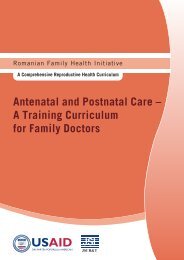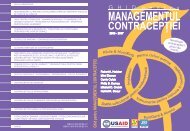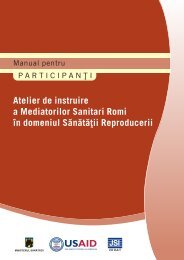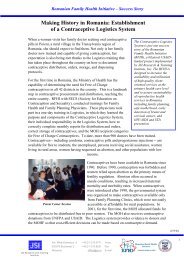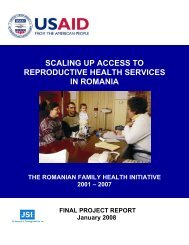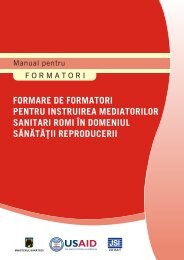Training of Roma Health Mediators in Reproductive Health
Training of Roma Health Mediators in Reproductive Health
Training of Roma Health Mediators in Reproductive Health
Create successful ePaper yourself
Turn your PDF publications into a flip-book with our unique Google optimized e-Paper software.
Discuss with participants how they can help a pregnant woman to have a safe delivery.<br />
• Dur<strong>in</strong>g pregnancy, the mediator can ask the pregnant woman where she plans to have<br />
the baby. Sometimes births take place at home, without any medical assistance<br />
(attended by an untra<strong>in</strong>ed person); sometimes both the mother and the baby are f<strong>in</strong>e<br />
and healthy, but home deliveries are dangerous because a serious problem may arise<br />
at any time and tra<strong>in</strong>ed medical help is not available.<br />
• The mediator can discuss with the pregnant woman and her family about the need to<br />
prepare <strong>in</strong> advance for childbirth.<br />
Ask participants:<br />
‣ What preparations should a family make for safe delivery?<br />
• The family should know the signs <strong>of</strong> labor and <strong>of</strong> emergencies.<br />
• They should also know the address and location <strong>of</strong> the nearest hospital<br />
• They should make arrangements for suitable transport (jeep, tractor or a bullockcart),<br />
so that the woman can be transported to the hospital <strong>in</strong> case an ambulance is<br />
not available. Some money should be kept aside for this purpose.<br />
• The family members must be prepared to donate blood if required by the woman<br />
dur<strong>in</strong>g any emergency.<br />
• Every pregnant woman should have the follow<strong>in</strong>g th<strong>in</strong>gs ready to take with her to<br />
the hospital (by the last month <strong>of</strong> pregnancy):<br />
o Soap and clean towels<br />
o Tooth brush and paste<br />
o Clean cotton or hygienic tampons<br />
o Clean clothes for mother and baby<br />
List their answers on the flipchart.<br />
Ask participants:<br />
‣ How many families do you th<strong>in</strong>k consider these preparations?<br />
‣ What happens when they have to go to the hospital <strong>in</strong> a hurry?<br />
Few families consider these preparations. As a consequence,<br />
• When an emergency arises, people panic and loose precious time identify<strong>in</strong>g an<br />
appropriate solution; they are unable to f<strong>in</strong>d solutions <strong>in</strong> a timely manner.<br />
• People discover the importance <strong>of</strong> the “small” th<strong>in</strong>gs the women needs, which<br />
may require additional visits to the hospital and more expenses for the childbirth.<br />
Divide participants <strong>in</strong> small groups <strong>of</strong> 4-5 persons and give to each group a case study<br />
(see tra<strong>in</strong>er document Case Studies). Ask the groups to study their case studies and to<br />
respond to the follow<strong>in</strong>g questions: (10 m<strong>in</strong>utes)<br />
• What is the woman’s current situation?<br />
• What did she and/or other family members do that led to this situation?<br />
109<br />
RFHI/JSI <strong>Roma</strong>nia <strong>Tra<strong>in</strong><strong>in</strong>g</strong> <strong>of</strong> RHMs <strong>in</strong> <strong>Reproductive</strong> <strong>Health</strong> Session 6: Pregnancy



